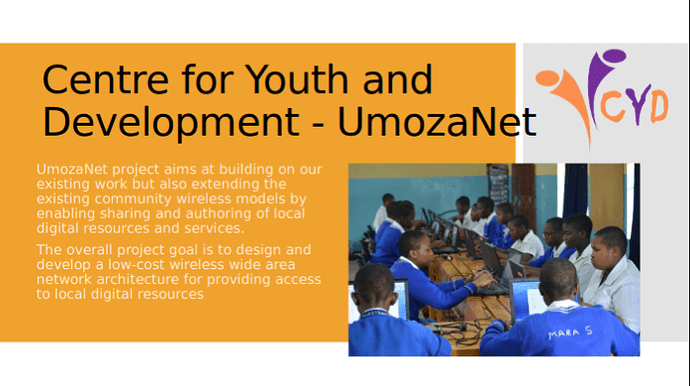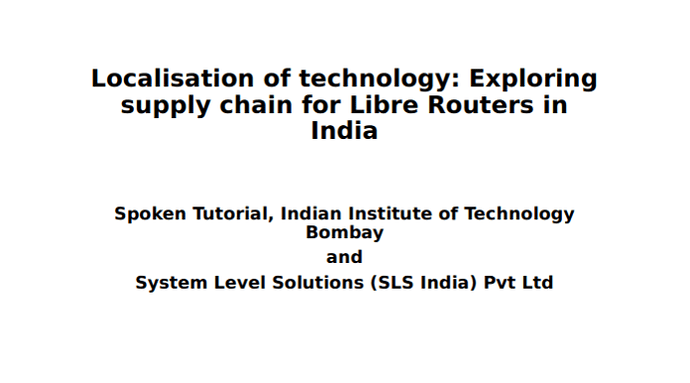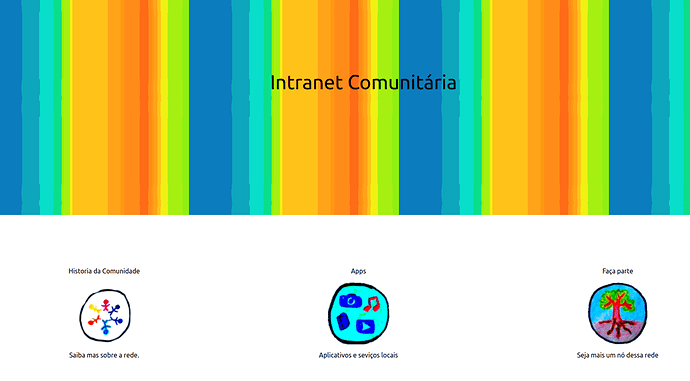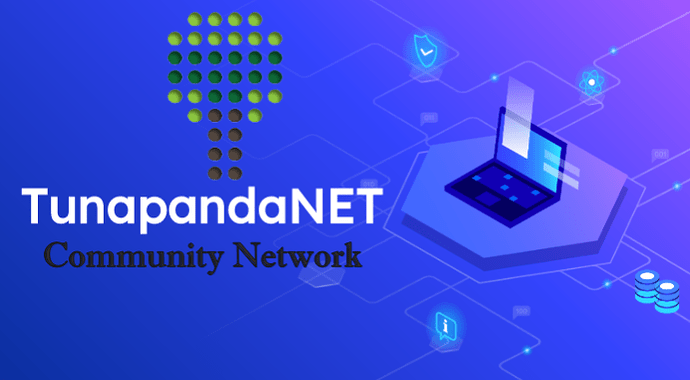Meeting notes
@nicopace : Hello everyone. @Doreen’s presentation is the first one. I am going to start the transmission…OK
Good morning / afternoon / evening everyone and welcome to this new space we hace created. I am Nicolas, part of this organisation. We are going to use the format of LightingTalks to talks about CN tech. A little bit of background: Our project is called LOCNET, steared by APC and Rhizomatica, working together with the peers who are with us on this session today. There is an interest to know more about technologies in CNs. Something that effects us all and the answers should come from you, the CNs. Instead of putting together information we want to inaugurate this new space to share what we are existed aboutm the challenges, things that have gone good or wrong. This is the spirit of the Lighting talks. The format is simple: each presenter has 5min, one after the other. And who comes next will be announces. Doreene is going to start, Sarbani comes afterward. I would appreciate those who will share to send their content before. Having said that, welcoming you all again. After the session of 10 presentations we will meet at Topia, a virtual space to play around and to talk about the topics of interests. Thanks for sharing. I am going to pass the mic to Doreen now.
@doreen CYD Malawi**, Umozanet**
- General presentation
- What is Kolibri
- Why Kolibri
- Our approach
- Challenges
@nicopace : Thank you @doreen, that was quite fast. We have to put a lot of rhythm…
@Sarbani_Banerjee_Bel, Localisation of Tecnology: Eyploring supply chains for Libre Router in India, Spoken Tutorial Project ITT India, SLS India
- Localisation of LR in India
Not possible use full potential of LR technology with high costs for shipment, also specific needs of rural communities. It becomes easier to take the basemodel of LR in other countries and adapt it.
- Trajectory of technology development
Development > Advancement > Standardisation
Foundational Technology as base > Difersification on based needs > Localisation
Working on a sustainable model, scale up the usage. How to meet the sustainability issue? Connect the usage to local job opportunities
-
SLS’s Role in LR Development
-
Joint effort between ITT; SLS and Altermundi
-
Final considerations
@padminirm ,Servelots India, Solar Protocol
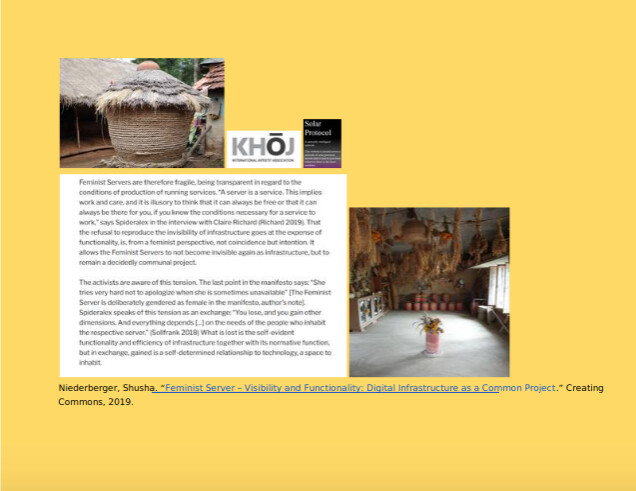
Explore the idea of a feminist server, imagined as a common. We want to run it in a slum area. Starting the project we are talking about data ownership by users and not companies and governments. What does it mean to maintain your own server, there is a link in the slide to check. A server is a service and it implies work and care. It can be a community project. How does one translate the idea of owning one’s own data, moving it into concepts of narratives. We are using the metaphor of a seedbank…a way of indigenous communities to store the seed. Important reference, take the farmer’s protests in India. Seeds are an important starting point to imagine date, starting from a feminists perspective, also breaking up the bug data prespective, and breaking it down in different data. Taking into acount an artist project, setting up a server in the community run by the sun, people the creating work around the server, art and other community member expressions, reimiaging data, for examplte through music and drumming. Think of data in myried ways. The community will be aware of having agency. An activist approach: many people feel they have now ownership or agency. An attempot through art and conversations and metaphors to make people think what is data and how to stuart it. It should be a safe space to bring the community togehter. More later…
Sanketh, Servelots India

Idea to establish a mesh network near Bangalore, in a “backward state” in Northern India. Idea to introduce a couple of Rasberry Pies to improve communication. But with Covid, the instalation was hard. So shipping the RPs to the regions, better then phones and labtops, just blackboxes, Also many families do not want to have children personal phones. In the RPs more learing experiences. RP4 was launched and it has higher Ram to launch Zoom calls or other services. But it took a lot of debugging. Before getting into those issues, I would like to know who is using and what you are using the devices for, especially RP4. We faced several issues: new USB ports and cables not always available. Also the powering with 5V 3A power was a challenge. Micro HDMI cables also not available. Very difficult to creat conectivity to activate the device because of a silly bug, not well documented. This is a challange working in remote locations. Please share on similar experiences…
@brunovianna Coolab, Intranet Comunitaria, Brazil*
[check: portal.coolab.org]
Very fortunate to come after the RP4 presentation because we are facing similar challenges with our project, also in regards to to feminist solar projects. Many services provided by CNs not easy to put them to work. We are working on this projects supported by Secure Scuttlebut project. Something imporant missing in many CNS: a hotspot in the house and leave the LRs to work in general conectivity. A device in the houses that could work as a device and provide services to the users could be great. We alread have some elements, Like Piranha but we have to make the resources more integrates, make them run on little hotspot servers, easy to sustain and confire for whoever will be maintaining it. We just saw, sometimes, RP is presented as a magical solutions but it is conceived for urban spaces, not taking into account week WIFI signals, high temperatures, etc. We tried several devices, not only RP. So the project has this goal, we do not have a public face for updates but we can offer to get in touch with us and exchange but the idea is to find out what would be the best device for a CN and then you could set up the captive portal, a device that would make sense to everyone. Pleased to continue the conversations after the lighthing talks.
Nico: Thanks Bruno, you gave me the perfect quue: Have a look in the communitynetwork.group. In this place besides Topia you can continue to engage. Now we have Alfons
@Alphonce , Tunapanda Network, Nairobi, Kenya*
My topic leads a bit away from data and servers. Our mayor role is to connect to unconnected and we believe in Internet is for everyone. So ust maybe a little bit about Tunapanda: a CN in Kibera, bridging the digital divide working with the community
-
Our Model: 1. Community-based NGOs, 2. Community Special Institutions, 3. Learning Institutions
-
Tunapanda Services: what matters is meaningful connectivity (IaaS, E-Learning Platform, Capacity Building/Digital Literacy, Content Creation and Development)
-
Big Concept: Promote Equal Digital Opportunities for everyone (equal access to digital platforms)
-
Tools and technologies (logical and technical tools)
-
Logical tools: …used to accomplish our missions (after connectivity whateles? eg. E-learning platform
-
Technical tools: …for network monitoring and management (Ubiquity Networking tool, Iperf tool, The Dude - Mikrotik Tool)
-
…the tech tool areas still exploring a lot…
- ToolKit Gaps
The identified gaps are: efficient monitoring tools, captive portals, mobile based e-learining platforms.
@Patacon , Altermundi, Where did my network go? An android app for LibreMesh, Argentina
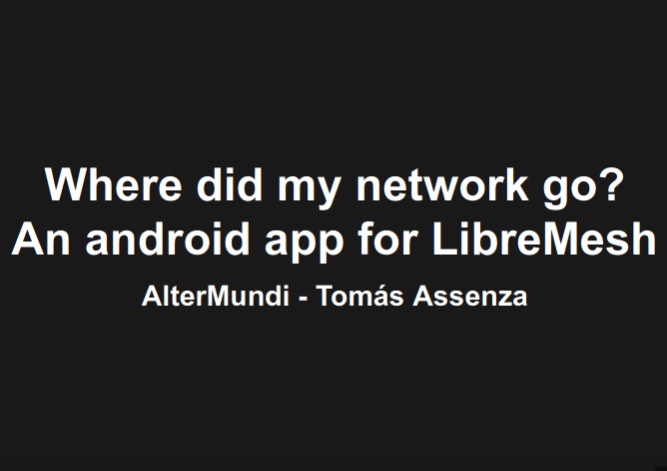
- Introduction: Proposal supported by Freifunk and Google (GSoC)…problems between network administrators and users, reporting problems in the local WIFI network
2.The project: an app with 3 objetives: develop a network selection app, minimizing the app weight, a friendly graphical interfaces
-
The app - logic: check if connection to a LibreMesh node, open a navegator that accesses the LiMe App
-
The app - GUI: WebView with tips
@imlaker , Bosco Uganda: Solar powered Network Infrastructure
- Brief Overview of Bosco Uganda
[check the video, supported by ISOC]
Just to wrap up: our connections are point to point. Each time we need new devices, the cheapest is about 150$US so we need two and this means 300US$ eaven for small distances, which is lots of money for us. So we are interested to learn about alternatives, thanks.
@batata , Coolab, uses of docker files, Brazil
Thanks for the invitation I would like to talk about dockers, most commercial servers use this to virtualize the servers in a light way. Virtual machines are software which permits to run a computer on another computer, A book in a book. But using the virtual machines is heavy and it needs lots of resoruces. In case of dockers, you will only have a few “pages of a book” in another book, it is very light, you choise hove many pages. Each machine has a container. THink of the sips traveling around the world with containers. Dockers use the container concept. The dock file also defines, wichich services will be run. Docker compose orquestrates, it is like composing music, different instrucments and a voices. The composer does a similar think like when creating music. The dicker file defines the song the docker is to sing. In the example the docker file defines how an etherpad will be run inside a RPi, the RPi parallely run 4 services; wordpress, calibre, etc. The example shows how the Eterhpad uses the server. Please let me know, if you want to know more…
Jesica, Altermundi, The experience of free community networks, Argentina
[live transcription from Spanish]
Can you hear me? I am Jessica, member of Altermundi and also of Quintana Libre, already 10 years working. Has been a time of many changes and learnings. We started in a very precarous way, using donations and gifts from tech companies, there was a moment when we had 6-7 different WiFi models and antena sets. And we started testing to know what would be the prefered ons. It was dificult at this time to build a real community network, in terms of sharing the knowledge if how to run the network. So we became aware that we needed a replicaply model so that this model would also work for the neighbors and the infra could be run commonly. Quinta Libre develope a replicable model, including the LibreRouters that rapidly became popular with others, too, due to its potential. The LR was informed by the needs of other CNs in Argentina and the world and it was created be people living with community networks, so it was conceived in this way. We wanted to homologize the technology to facilitate the colaboration, so people could learn from each other, also making possible the use of donated equipment. In Quintana Libre it was difficult to detect all the different problems in all the different devices at first and all depends of cours on the resources that a community has to update itself. And the same thing happens wih the CNs. Not only the sotware is important but the specifically the frontend has to be useable by many, GUIs for people with few technical skills, so working with LibreMesh means to look for such solutions, help to close the gap of complexity between the updates between different versions. All people participating should be able to contribute.
@brunovianna ,Caramelo, a stray watchdog for remote routers, Coolab, Brazil
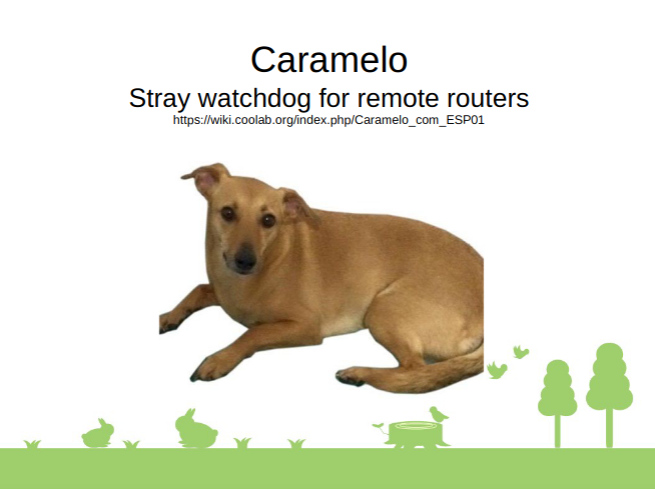
Problem: sometimes the rooter froze and we had to restart the device. We called the device “Caramelo”, more a stray then a watchdog, and all straydogs share this color. So the device is really simple, ESP-01 microchips that are very cheap and can connect with WiFI, a Relé, and a programer. So what we do is connect the Relé to the ESP-01 chip watching the wifi connection and if the Ping does not work it will mechanically switch on and off. This shows how it works. All the explainations are on the Coolab Wiki. You connect the programmer to your computer, you download the code from the web and specify the wifi network specifities. You see how to install it. You have to cut open the power cord of the router to put in Caramelo. Then you will need some extra power. This is the stray dog watch dog project.



 (intranets)
(intranets)